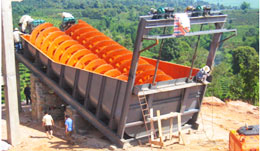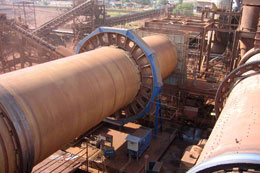-
Sand Making Crusher
- PCL-Vertical Shaft Impact Crusher
- SBM Hydraulic VSI Crusher
- VSI5X Series Impact Crusher
Barite mining equipment
Barite mining process

Commercial barite is mined from surface or near-surface deposits by open-pit or underground mining methods. The broken ore is trucked to the processing plant where it may be washed by log washer or trommel screen to remove adhering clay and low-grade fines before reduction by jaw or impact crusher to 25 cm or finer for further processing. The degree of further processing and concentration depends on the grade of ore, identified end use, and liberation size (i.e., the size at which the barite is essentially free of contaminating impurities). If a further size reduction is required, this can be accomplished by jaw crusher, impact crusher, cone crusher, or roll crushers.

The concentrated barite may be ground to final size specifications by roller mill, paddle mill, or other suitable unit. A 45-micrometre (μm) product is normally specified for drillmud barite; however, a much finer product may be required for other applications such as chemical and pharmaceutical preparations. Barite used for drilling petroleum wells must be finely ground so that at least 97% of the material, by weight, can pass through a 200-mesh (75-μm) screen, and no more than 30%, by weight can have an effective diameter of less than 6 μm, which is measured using sedimentation techniques. The ground barite must also be dense enough so that its specific gravity is 4.2 or greater, soft enough to not damage the bearings of a tricone drill bit, chemically inert, and contain no more than 250 mg/kg of soluble alkaline salts. A small percentage of iron oxide is allowable.
- Limestone Crusher
- Barite Crusher
- Granite Crusher
- Kaolinite Crusher
- Calcite Crushing
- Tombarthite Crusher Mill
- Bentonite Grinding Plant
- Basalt Ore Crusher
- Lignite Crusher Mill
- Silica Ore Crusher
- Tin Ore Mine
- Lead and Zinc Ore Crusher
- Ochre Crusher Mill
- Garnet Crusher
- Mica Crusher
- Asbestos Crusher
- Manganese Ore Crusher
- Talc Crusher Mill
- Feldspar Crusher
- Iron Ores Crusher
- Dolomite Crusher
- Quartz Crusher
- Gypsum Crusher
- Calcium Carbonate Grinding
- Barite grinding plant
- Barite process
- Barite beneficiation
- Barite mining process
- Barite quarry Mahinery
- About Us
- |
- Service
- |
- News & Events
- |
- Contact Us
- |
- Resources
- |
- Showroom
Aggregate Crusher
Artificial Sand Making
Ballast Crushing Machine
Basalt Stone Crusher
Barite Mine Process
Beneficiation Plant
Bentonite Crusher
Bentonite Milling
Calcium Carbonate Crusher
Calcium Carbonate Grinding
Cement Grinding
Concrete Crusher
Coal Crusher
Copper Crusher
Cement Mill
Chrome Mining Process
Copper ore Beneficiation
Coal Processing
Coal Pulvarizer
Feldspar Crushing
Feldspar Grinding
Flotation Machine
Gold Crusher
Gold Mine Equipment
Gold Processing Machinery
Granite Crusher
Granite Crushing Machine
Granite Quarry Equipment
Gypsum Crusher
Gypsum Mining
Gypsum Powder Production
Iron Ore Beneficiation
Iron Ore Crusher
Kaolin Processing Plant
Limestone Crusher
Silica Sand Crusher
Iron Ore Mining Equipment
Cement Production Line
Talc Production Line
Quartz Crushing Machine
Limestone Mining Process
Manganese Benificietion
























